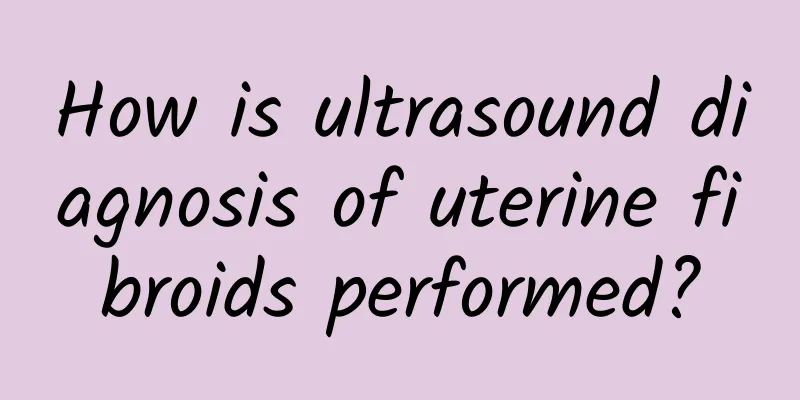How is ultrasound diagnosis of uterine fibroids performed?

|
What is the ultrasound diagnosis of uterine fibroids? Uterine fibroids are a relatively common benign gynecological tumor, also known as uterine fibroids. There are generally no symptoms in the early stages of the disease and they are only occasionally discovered during pelvic examinations or ultrasound examinations. So, what is the ultrasound diagnosis of uterine fibroids? Let's learn about it together. According to the location of uterine fibroids, they can be divided into intramural fibroids, subserosal fibroids, and submucosal fibroids. Different growth locations will display different ultrasound images, as follows: Subserosal fibroids The uterus is enlarged and morphologically abnormal, with the serosa protruding outward in a round or semicircular shape, showing weak or moderate echoes. Local pressure scanning and dynamic observation show that there is no separation between the tumor and the uterus. CDFI detection: There is a ring-shaped blood flow signal around the tumor and it extends to the tumor. Subserous myomas protruding into the broad ligaments on both sides of the uterus are called broad ligament myomas. They often appear as solid round tumors on one side of the uterus, with a large volume, only one pedicle connected to the uterus, and are easy to change; the color blood flow signal of the pedicle originates from the uterus, and its color blood flow signal surrounds the tumor. Intramural fibroids Most of them are hypoechoic, of varying sizes, with intact capsules, clear boundaries between the tumor and the normal myometrium of the uterine wall, and annular colored blood flow signals around them. When the fibroids are large, they can compress and push the uterine cavity, causing the echo of the endometrium to shift or deform. Submucosal fibroids The endometrium is deformed or defective, and low-echo nodules can be seen in the sub-endometrial myometrium protruding into the uterine cavity. When the fibroids completely protrude into the uterine cavity, the uterine cavity shows a solid mass, but there is a gap between the fibroids and the endometrium, showing a "uterine cavity separation sign". CDFI detection: There are ring-shaped or semi-ring-shaped blood flow signals around the tumor, and strip-shaped blood flow signals inside. Myoma degeneration Hyalinization, cystic change, and calcification are the most common. Hyalinization is usually an echo-free area with unclear edges and enhanced echoes in the back in large fibroids larger than 4 cm. Cystic change, on the other hand, appears as a circular echo-free area with clear boundaries. Myoma calcification appears as a light mass or arc-shaped light band with strong echoes, accompanied by acoustic shadows in the back, and is more common in postmenopausal uterine fibroids. Localized fatty degeneration of fibroids may appear as strong echoes but without acoustic shadows. Red degeneration of fibroids is related to pregnancy, and the sonogram shows liquefaction. Postmenopausal uterine fibroids grow rapidly, with uneven internal echoes and irregular boundaries. The possibility of sarcoma degeneration should be considered, which is rare. Ultrasound examination is currently the most commonly used auxiliary diagnostic method. It can show the enlargement of the uterus, irregular shape, the number, location, size of fibroids, and whether the interior of the fibroids is uniform or liquefied, cystic, etc. Ultrasound examination is helpful in diagnosing uterine fibroids, providing a reference for distinguishing whether the fibroids have degenerated, and helping to distinguish them from ovarian tumors or other pelvic masses. |
<<: How is pelvic inflammatory disease transmitted?
>>: What are the symptoms of adnexitis?
Recommend
Many people are also concerned about how many times a woman can have a medical abortion?
At present, many women will choose medical aborti...
Can drinking coffee before exercise help you lose weight? Do this to avoid NG
Moderate drinking of coffee not only has a refres...
Lose weight during the menstrual cycle, slim down in 28 days! Traditional Chinese Medicine: 4 stages of "eating like this" to build a physique that is easy to lose weight
Girls can also successfully lose weight by using ...
The harm of having uterine fibroids after marriage. Can you get pregnant with uterine fibroids after marriage?
Among gynecological diseases, uterine fibroids ar...
Can I eat hot pot after abortion?
You can eat hot pot after abortion, but it is rec...
What medicine should I take if I have small uterine fibroids? What medicine should I take to treat small uterine fibroids?
What medicine should I take if I have small uteri...
Can female vaginal infection cause cervical erosion? 4 causes of cervical erosion that you should know
In life, it is very important for women to develo...
How much does menopause surgery cost?
When it comes to the treatment of menopause, many...
Does adenomyosis need treatment when approaching menopause?
Does adenomyosis need treatment when approaching ...
Does brown color after taking progesterone count as menstruation?
Brown discharge after taking progesterone is usua...
What are the chances of pregnancy with thick endometrium?
Can you get pregnant if your endometrium is thick...
"Peak fasting" is more effective in losing weight! It is best to fast 3 hours before going to bed. Eating avocado has 4 unexpected benefits
I believe many people have had this experience wh...
TCM causes of postpartum menstrual irregularities in women
Irregular menstruation can occur in postpartum wo...
What fruits can I eat after an abortion? What is the best thing to eat after an abortion?
1. Dietary considerations after abortion surgery ...
Is cervical erosion caused by sexual intercourse?
Will sexual intercourse lead to cervical erosion?...









